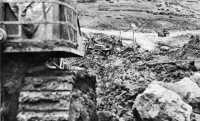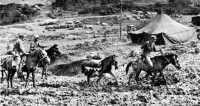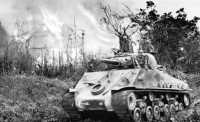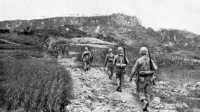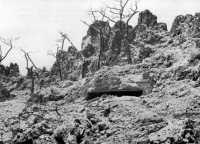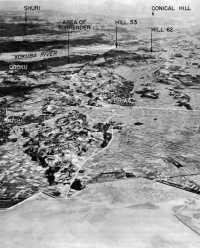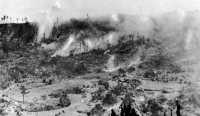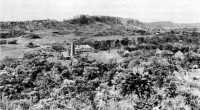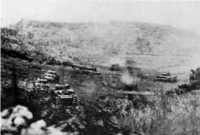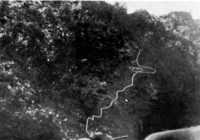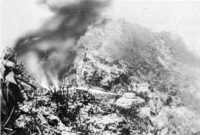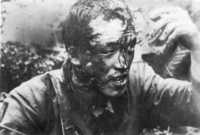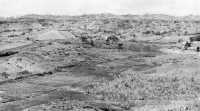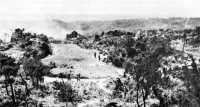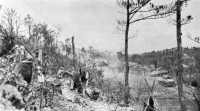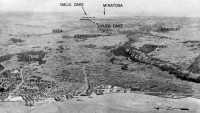Chapter XVII: The Enemy’s Last Stand
“Ushijima missed the boat on his withdrawal from the Shuri Line,” General Buckner declared on 31 May as he reformed his ranks for the pursuit and final destruction of the 32nd Army. “It’s all over now but cleaning up pockets of resistance. This doesn’t mean there won’t be stiff fighting but the Japs won’t be able to organize another line.” Other officers also did not credit the enemy with the ability to execute an orderly withdrawal.1 This optimism proved soon to be largely unfounded. It was to be learned that the enemy had withdrawn his forces from Shuri effectively and in time to organize a new line in the south. The enemy’s maneuver, though it did not result in setting up a formidable line of defense, was to necessitate more than three crowded weeks of pursuit and fighting by the American troops to bring organized resistance to an end.
The Push South to the Yaeju-Duke – Yuza-Dake Barrier
On 31 May General Buckner extended the Army boundary along the road joining the villages of Chan, Iwa, and Gushichan. He ordered his two corps to complete the encirclement of Shuri in order to cut the remaining Japanese troops into large segments. General Buckner and his staff still hoped to isolate a large portion of the 32nd Army and prevent its withdrawal from Shuri; thus the two corps were directed to converge at Chan “in order to pocket enemy north this point.” III Amphibious Corps was then to secure Naha and its airfield while XXIV Corps drove rapidly southeast to prevent the enemy from retiring into the Chinen Peninsula. General Buckner expected the Japanese, without skilled men or adequate transportation or communications, and hindered by boggy roads, to experience trouble and disorder during their mass retreat.2
Mud was a major concern of American commanders. Nearly twelve inches of rain had fallen during the last ten days of May and more was expected during the first part of June. Although 400 trucks had been used on 30 May to dump coral and rubble into the mudholes on Route 5, the main north-south
road through the center of Okinawa, it was closed the following day to all but the most essential traffic. Other supply routes along the east and west coasts were in almost impassable condition. At the time when General Buckner ordered his troops to “drive rapidly,” supply trucks were moving toward the front only as fast as they could be dragged by winches or bulldozers through the numerous quagmires. Units on each flank were using boats or amphibian tractors to transport supplies from rear areas to forward dumps, but they still faced the problem of moving food and ammunition from the beaches to the front-line foxholes. Center divisions were under a still greater strain. Much of the ammunition, food, and water was carried forward by reserve units – sometimes by men from the assault companies.
“We had awfully tough luck,” said General Buckner, “to get the bad weather at the identical time that things broke.” His deputy chief of staff considered the mud to be as great a deterrent to the attack as a large-scale enemy counterattack.3
The Japanese Make Their Escape
The XXIV Corps occupied the southernmost positions of the American front. General Hodge shifted the 7th Division toward the east and ordered the 96th to move south, relieve the 32nd Infantry, and take up the western end of the Corps line. The 77th Division became responsible for protecting the rear of the 96th and for mopping up the part of the Shuri line which was in the XXIV Corps sector. By evening of 31 May, the 7th and 96th Divisions reached the Corps’ objective, and they were ready to start south on the following morning.4
The lines of the III Amphibious Corps stretched from Shuri to a point 1,000 yards southeast of Naha; its nearest position was more than 3,000 yards from the dominating ground near Chan where General Buckner still hoped to converge spearheads of his two corps and to reduce Ushijima’s force to segments. This hope disappeared by the night of 31 May, when the performance of the 96th and 7th Divisions indicated that General Ushijima had already accomplished his sly withdrawal despite the difficulties of mud and communications. When it became apparent that the Japanese withdrawal had frustrated American hopes of splitting the enemy forces, Tenth Army revised its plans
and permitted the III Amphibious Corps to attack down the west coast and the 7th Division to proceed down the east flank.5 (See Map 51.)
When the attack toward the south began on the first day of June, it was planned that the Marines should destroy the remaining Japanese rather than isolate them. Patrols from the III Amphibious Corps soon discovered that only a thin shell of defenses remained near Shuri. General Geiger decided, therefore, to push the 1st Marine Division directly south to seal the base of Oroku Peninsula, and he also made plans for an amphibious landing by the 6th Marine Division on the tip of the peninsulas.6
Four miles south of the front line loomed another coral escarpment, the largest on the Okinawa battlefield. This was the Yuza-Dake–Yaeju-Dake, which formed a great wall across the southern end of the island that had been visible since the early days of the campaign. The central part of the island between the American front lines of 31 May and the Yaeju-Dake consisted of a series of comparatively small rounded hills and uneven low ridges; a few larger hills stretched across the base of the Oroku Peninsula on the west side of the island. The highest hills south of the landing beaches were on the east side of southern Okinawa and on Chinen Peninsula, which consisted entirely of hilly ground except for the narrow strip of flat land at the shore.
Pursuit in the Mud
Dense fog banks covered southern Okinawa on the morning of I June. Visibility extended for only a few yards and mud was ankle-deep as the Americans attacked south to catch up with Ushijima’s escaped army before it should have time to burrow into a new defensive line. On 1 June the Japanese defended two hills in front of the 7th Division, and during 1-2 June they made a solid stand in the zone of the 96th near Chan. Otherwise there was only spotty resistance of delaying and nuisance value until 6 June. On that day the pace of the American troops was retarded by vigorous enemy action to the front and by the overextension of the supply lines of the front-line units.7
Most of the hills were either defended by thin enemy forces or had been completely abandoned, and a lack of skill was noticeable among the enemy troops encountered. As American troops approached their positions the Japanese offered
ineffectual fire until the attack drew close, and then frequently tried to escape by running across open ground. They became easy targets for riflemen and machine gunners, who were quick to see and respect skill in their opponents and as quick to feel disdain for spiritless mediocrity. S/Sgt. Lowell E. McSpadden, a member of the 383rd Infantry, expressed the attitude of the infantrymen toward these inferior troops when he stepped up behind two Japanese soldiers without being seen, tapped one on the shoulder, and then shot both with a .45 caliber pistol which he had borrowed for the purpose.8
After the first day of the pursuit, rain was more troublesome and constant than enemy interference. The 184th Infantry waded south and east over the green and rain-soaked hills on Chinen Peninsula against light opposition that indicated an absence of enemy plans for a defense of that area. General Arnold, moving to speed up operations, committed the 32nd Infantry to patrolling the northern part of the peninsula.9 Late in the afternoon of 3 June, patrols from the 1st Battalion, 184th, reached the southeast coast of Okinawa near the town of Hyakuna and completed the 7th Division’s first mission: It had been, General Buckner said, a magnificent performance.10
General Hodge doubted that his corps could have continued its pace had it not been for previous experience in the marshes of Leyte.11 Only flimsy resistance faced the 1st Marine Division, but its supply system had collapsed and the battalions had to rely upon air drops or carrying parties. By 3 June the gap in depth between the two corps had increased to 3,000 yards, and the 383rd Infantry was subjected to harassing fire from its exposed right flank. To protect his corps’ flank, General Hodge sent the 305th Infantry, 77th Division, south to fill the increasing void.12
Toward the Yaeju-Dake
In the meantime the 2nd Battalion, 5th Marines, crossing the Corps boundary north of Chan, attacked southwest through Tera and secured Hill 57 and the high ground south of Gisushi, thus reducing the gap to 1,000 yards.
With the elimination of possible defensive terrain on Chinen Peninsula and in central southern Okinawa, it was becoming evident by the evening of 3 June that General Ushijima intended to stage his final stand on the southern
Mud and supply were major problems in pursuing the Japanese southward from Shuri. Success depended largely on the ability to move American supplies over bad roads. The tractor is pulling a reconnaissance car uphill from a portable bridge in the hollow
When roads became impassable to motor vehicles, horses were used
tip of the island, almost certainly on the Yaeju-Dake Escarpment, which lay within the zone of the III Amphibious Corps. Moreover, if the XXIV Corps maintained its pace for one or two days longer, as seemed likely, it would have secured its portion of southern Okinawa. In order to deny the enemy a breathing spell before the final period of combat, General Buckner shifted the Corps’ boundary to the west so that the entire escarpment fell within the zone of the XXIV Corps. Effective at noon on 4 June, the boundary between the corps changed from the road connecting Iwa with Gushichan to the road connecting Iwa with Yuza, Ozato, and Komesu.13 (See Map 52.)
Shifting their direction of attack on 4 June to the southwest, General Hodge’s troops moved across the small, tidy fields, the rice paddies along the sea, and the hills luxuriantly green from the continuing spring rains. By midafternoon the 7th Division had secured more than 6,000 yards of coast line and had reached the soggy banks of the Minatoga River. Infantrymen waded the swollen stream, the only bridge having been destroyed. The 96th joined on the west to extend the Corps line from Minatoga to Iwa. To the south the Japanese had prepared the outposts of their next important line, which was to be their last. Behind the American lines the supply routes, now stretched beyond an unbridged river, were strained to the limit. Commanders immediately explored the possibilities of landing supplies at Minatoga. During the several days that followed, the American troops crowded steadily but more cautiously forward against a heavy and determined opposition that was reminiscent of previous fighting and suggested that the enemy’s last line was close at hand.14
The Capture of Oroku Peninsula
It was only by chance and whim that the Oroku Peninsula was defended by the Japanese after the Shuri line was abandoned. Before 1 April enemy naval units were responsible for this two-by-three-mile peninsula and the installations emplaced there to protect the airfield and the city of Naha. A few days before the American landings took place, but after the threat of invasion made it either impossible or unnecessary for the naval units to continue with their more specific missions, they were consolidated under the Okinawa Base Force. Most of the Navy personnel congregated on Oroku Peninsula. The Okinawa Base
Force, commanded by Rear Admiral Minoru Ota, was in turn responsible to the 32nd Army, toward which Ota adopted a policy of complete cooperation.15
The total strength of enemy naval units on Okinawa was originally nearly 10,000 men; less than a third of that number, however, belonged to the Japanese Navy, the majority being either recently inducted civilians or Home Guards. Of the men who made up the construction units, the naval air units, the Midget Submarine Unit, and the other organizations that became a part of the Base Force, only two or three hundred had received more than superficial training for land warfare. None of these naval units participated in combat until the counterattack of 4 May, when a limited number of naval troops were sent to the front line and sustained very high casualties. Other units were subsequently fed into the front lines. The 37th Torpedo Maintenance Unit was almost completely destroyed when, with three times as many men as rifles, it entered the fighting at Shuri and Yonabaru toward the end of May.
The greatest misfortune affecting the ultimate fate of the enemy naval forces occurred at the time of the mass exodus from Shuri. The 32nd Army headquarters directed all naval troops to fall back on 28 May to a new defense area, near the coastal town of Nagusuku. Because of an ambiguously worded order, the remaining men of the Base Force destroyed most of the weapons and equipment which they were unable to carry; they then moved south on 26 May, two days before they were scheduled to withdraw. When they arrived at their assigned area they found it totally unsuited to the type of fighting for which they were prepared, as well as inferior to the area they had just left. Disgusted with their new sector, the young officers asked Ota for permission to return to Oroku “to fight and die at the place where we built positions and where we were so long to die [ sic] in that one part of the island which really belonged to the Navy.” Advocates of independent action by the Navy succeeded in persuading Ota of the advisability of returning the troops to Oroku. Without consulting the Army Ota ordered the troops back on 28 May, and the return was effected that night. Naval troops numbering about 2,000 returned to their former positions. Some Navy personnel stayed in the south to fight on the Yuza-Dake or Yaeju-Dake line; the rest of the original 10,000 had been used up in the previous combat.
Naha airfield, the largest and most important which the Japanese had constructed on Okinawa, was at the northern end of a strip of flat land on the
Advancing to Yaeju-Dake through the Iwa area, American tank passes burning native house, fired to lessen danger from snipers
A patrol of the 381st Infantry, 96 Division, moving south toward Yaeju-Dake
Last point of resistance in the Oroku Peninsula was Hill 57, shown above in panorama. Below is a close-up of a concrete emplacement (dotted outline in photo above) after it had been blasted open by Marine artillery fire
west side of Oroku Peninsula. The rest of the peninsula was wrinkled with ridges and hills up to 2000 feet in height but was lacking in any pattern or dominant terrain features. Between the hills were valleys planted in sugar cane and other dry crops; the valleys had been sown with mines and were carefully covered by automatic weapons firing from camouflaged cave openings.
An Amphibious Assault
A shore-to-shore movement would offer suitable landing beaches and orient the American attack in the direction that afforded the best use of supporting artillery. This plan of attacking from the sea would also provide for supply by sea, made necessary by the break-down of roads. Therefore General Shepherd, commander of the 6th Marine Division, ordered the 4th Marines, followed by the 29th, to make a landing. Planning and organization had been completed by the evening of 3 June. At 0445 on the following morning supporting artillery began an hour-long preparation during which 4,300 shells fell on the high ground in front of the landing beaches. With amphibian tanks in the lead the 1st Battalion, 4th Marines, embarked from the assembly area north of the Asato River and headed south toward the northern point of the Oroku Peninsula. The formation was partially broken when some of the amphibian tractors, which had been used by the marines to haul supplies to the front during the rainy period, failed after getting under way, leaving elements of the assault force stranded in the water. There was only light fire, however, when the first troops stepped ashore a few minutes before 0600 and the men hurried inland to carve out a beachhead sufficiently large to warrant landing the remainder of the force. An hour and a half after the landing the two assault battalions were 900 yards inland, and twenty-four tanks and four self-propelled guns were ashore; by 1000 the 29th Marines was ordered to land and take up the north end of the division line. The landing was proceeding satisfactorily.16
As the 4th Marines landed on the north point of Oroku the 6th Reconnaissance Company seized Ono–Yama, a small island in the center of the Naha Inlet which formed the anchor for two destroyed bridges linking Naha to the peninsula. A few defenders were killed, and the island was in American hands an hour after the assault commenced. Replacement of the bridges, necessary to provide adequate logistical support, was hindered by Japanese machine-gun and 20-mm. shell fire, and it was not until the following day that the final sections of a ponton bridge were floated into place.
Mud, Mines, and Machine Guns
At the end of the first day assault battalions, 1,800 yards beyond the point of the landing, faced stabilized enemy fire power from a wealth of automatic weapons varying from light machine guns to 40-mm. cannons. It was later learned that many of these weapons had been stripped from damaged planes, adapted for use by ground troops, and, with painstaking care, hidden underground behind narrow, camouflaged firing ports that overlooked the mines own valleys and other approaches to the defended hills. The 10-day battle for Oroku Peninsula is the story of a half-trained enemy force, poor in standard weapons, organization, and hope of eventual success, but possessed of abundant automatic fire power, a system of underground positions larger than they could man, and a willingness to die in those positions in order to make the Americans pay dearly for the ground.
Gains were slowed down on the second day and came to an abrupt halt when the 29th Marines, on the northern flank, hit a hard core on Hill 57 near the center of the- peninsula. With progress least difficult on the right (south), General Shepherd tried to crowd the 4th Marines forward to outflank the enemy’s positions. The southern end of the line yielded as far as the village of Gushi; then the entire line, 4,000 yards long, faced a tight ring of Japanese defenses that held the marines to slight gains for two more days, 7 and 8 June. Use of tanks was restricted by mud and the widely scattered mine fields, which were protected by abundant machine-gun fire. Three platoons of tanks helped in the capture of Hill 57 on 7 June, but usually the tanks were bogged in mud or fenced off beyond direct-support range by mine fields. In three instances when men from the 2nd Battalion, 4th Marines, were unable to fight their way to the top of a hill, they used the extensive tunnel systems and went through the hills rather than over them.
Meanwhile, the 1st Marine Division had freed itself from the mud, and on 6 June it was halfway across the base of Oroku Peninsula, closing the gap between the two corps but exposing its own west flank. General Shepherd committed the Corps reserve, the 22nd Marines, sending them south to establish a line across the base of the peninsula. This placed elements of the division on opposite sides of the Japanese troops on Oroku, and General Shepherd, recognizing that the logical avenues of entry to the Japanese hill positions were from the south and southeast, ordered the 22nd to patrol to the northwest and then to attack in that direction. The 4th Marines was ordered to attack on the left of the 22d’s line.
With three regiments thus engaged in the fight, the division continued to concentrate on an encircling move to compress the Japanese on the high ground near Tomigusuki. There were no soft spots along the enemy line, and each slow advance the marines scored was against machine-gun and 20-MM. and 4o-mm. antiaircraft fire. Fighting proceeded with the same sustained effort by both sides through 10 June, when the remaining Japanese were confined in an area no larger than 1,000 by 2,000 yards. Subjected to extreme pressure, the Japanese during the night of 10 June erupted in a series of local counterattacks along the entire front. Two hundred enemy dead were scattered along the front lines on the following morning.
End of the Okinawa Base Force
General Shepherd struck back at the Japanese at 0730, it June; he employed the greater part of eight battalions and supported them with tanks, which after several days of clear weather were no longer restricted by mud. This was planned as the final blow to break through the enemy resistance. The 29th Marines attacking from the west, and the 4th moving from the south, made only slight headway; the 22nd Marines, after an intense artillery barrage, drove toward Hill 62 from the southeast. The first attack stopped short of the objective, but, about noon, the 2nd Battalion, 22nd Marines, rammed another assault against Hill 62 while the 3rd Battalion moved off for Hill 53, about 300 yards north. The first of these objectives fell by 1330, and Hill 53, which afforded observation of the remainder of the enemy-held ground, soon afterward. The three regiments held a tight ring in an area 1,000 yards square.
A break-up in the Japanese forces occurred on the following day. As the converging forces closed in on the remaining pocket, the Japanese were forced from the high ground onto the flat land near the Naha Inlet. Some chose to fight until killed; others, including several who lay down on satchel charges and blew their bodies high in the air, destroyed themselves. On 12 June and the day following, 159 surrendered-the first large group of Japanese taken prisoner.
When the destruction of his force was nearly complete, Admiral Ota committed suicide. On 15 June, as patrols sought out the last of the Japanese on Oroku, the marines found Ota’s body and those of five members of his staff lying on a raised, mattress-covered platform in one of the passages in the underground headquarters. Their throats had been cut, and, from the appearance of the room, it was apparent that an aide had carefully arranged the bodies and tidied up after the self-destruction of the Japanese officers. Nearly 200 other bodies were found in the headquarters, one of the most elaborate underground systems on the
island. More than 1,500 feet of tunnels connected the office rooms, which were well ventilated, equipped with electricity, and reinforced with concrete doorways and walls.17
The slow and tedious battle for Oroku Peninsula had lasted for ten days. The total number of marines killed or wounded was 2,608, a cost in casualties proportionately greater than the American forces suffered during the fighting for Shuri, where they were opposed by General Ushijima’s infantrymen.
Six days before the 6th Marine Division wiped out Admiral Ota’s force, and four days after the XXIV Corps separated Chinen Peninsula from the rest of the battlefield, the 1st Marine Division reached the west coast above Itoman. Besides straightening Tenth Army front lines between that village and Gushichan, this advance opened a water supply route for the advance elements of the III Amphibious Corps.18
Assaulting the Last Defense Line
When the rainy period on Okinawa ended on 5 June, troops of the XXIV Corps occupied a solid line across 6,000 yards of soft clay. Supply was critical and was partially dependent upon air drops. Tanks could not operate, and to the front, 1,000 or 1,500 yards away, stood the craggy Yaeju-Dake and Yuza-Dake hill masses-physical barriers which, together with Hill 95 on the east coast, formed a great wall across the entire XXIV Corps sector from Gushichan to Yuza. The highest point of this 4-mile-long cliff was the Yaeju-Dake Peak, which rose 290 feet above the adjoining valley floor. Because of its shape the troops who fought up its slopes named it the “Big Apple.” The Yuza-Dake stood at the west end of the line and then tapered off into Kunishi Ridge, which extended across the III Amphibious Corps’ sector. Hill 95, which paralleled rather than crossed the direction of attack, formed the eastern anchor. On the seaward side of Hill 95 there was a 300-foot drop to the water; on the side next to Hanagusuku village there was another sheer drop of about 170 feet to the valley floor. The only break in this defensive wall was in the 7th Division’s sector, where a narrow valley pointed south through Nakaza. This approach to the high tableland beyond the escarpment cliff was subject to fire and observation from both flanks.
Between this redoubtable terrain and the front occupied by XXIV Corps on the evening of 5 June were a few grassy knolls and numerous small hills scattered
Base of Oroku Peninsula, where Okinawa Base Force made its last stand
over a generally flat valley. After two weeks of almost continual rain, the valley was rich with verdure and thus far only slightly torn by shells and combat.
General Ushijima’s army reached this new defensive area several days ahead of the Americans and, by 3 or 4 June, was deployed in the caves and crevices in and behind the escarpment wall. The combined strength of 32nd Army infantry units was about 1 1,000 men. Total enemy strength, however, amounted to nearly three times that number. It included personnel from artillery or mortar units which no longer possessed weapons; signal, ordnance, airfield construction, and other units whose normal duties were no longer necessary; and conscripted Okinawans whose ability and will to fight did not equal those of the regular Japanese soldiers.19
About 8,000 men made up the Japanese 24th Division, which, as his strongest unit, General Ushijima stationed in the center and across the west flank from Yaeju-Dake to the town of Itoman. The 62nd Division, originally the 32nd Army’s best but now reduced to two or three thousand men, took up reserve positions near Makabe. This left only the 44th Independent Mixed Brigade to defend the eastern part of the enemy’s final line facing the 7th Division. Around these three original major combat units General Ushijima grouped the remaining service and labor troops, scattered naval personnel, and Okinawan conscripts. Thus, with a heterogenous army lacking in adequate training, artillery support, communications, and equipment and supplies, General Ushijima waited for the final battle. His headquarters took only a 20-day supply of rations when it moved from Shuri to the southern tip of the island-an indication of his own appraisal of his army’s capabilities.
Both sides watched warily and prepared for the Americans’ next assault. The state of supply, the condition of the narrow roads linking assault elements with supply dumps at Yonabaru, and the lack of armored and direct-fire weapons prevented an immediate large-scale attack by the XXIV Corps. American commanders probed the enemy line with patrols, regrouped their forces, and assembled necessary supplies through the little port of Minatoga, which was in operation by 8 June.20
Yaeju-Dake was brought under American artillery fire shortly before the infantry attempted its first advance to the escarpment. Burst at upper left is white phosphorus
Hill 95, near Yaeju-Dake, with Gushichan in foreground
Locating Enemy Strength
One of these probing actions made a slight penetration of the enemy’s line and soon revealed the nature and volume of the enemy fire power protecting the final Japanese line. Nearest the Big Apple Peak was the 381st Infantry, first to venture into the Yaeju-Dake and the first to be driven back. West of the Big Apple was a secondary escarpment, like a step, about halfway to the top. Col. Michael E. Halloran ordered the 1st Battalion to explore this area and, if possible, to seize a lodgment on the lower part of the escarpment which would permit an attack against the Big Apple from the west and against the flank of the enemy’s most dominating fortification.21
On the morning of 6 June the battalion commander, Maj. V. H. Thompson, leapfrogged his companies through Yunagusuku against only half-hearted opposition and then sent Company B, under Capt. John E. Byers, forward to test the escarpment wall. Three squad-sized patrols crept through bands of fire from machine guns, some of which were so far inside caves that they could not be destroyed with grenades, and reached the lower of the two escarpments. The rest of the company followed, and Thompson ordered Company C to move abreast and left of Byers’ men. It was midafternoon, and the first attempt at penetration of this largest escarpment on Okinawa was proceeding with promise of success. Company C started across the open rice paddies to the base of the cliff, and Company B moved up a steep trail leading to the intermediate level of the escarpment. This movement went beyond the line of enemy delaying action and into the area where General Ushijima had ordered his army to “bring all its might to bear” to break up the American attack and exact a heavy toll of the attacking force. “To this end,” he instructed, “the present position will be defended to the death, even to the last man. Needless to say, retreat is forbidden.”22
The Japanese waited patiently until both companies were in a belt of preregistered fire, then opened up with machine guns and 20-mm. dual purpose guns in sufficient quantity to lace both companies with beads of automatic fire. Major Thompson immediately started to organize a withdrawal and employed ten battalions of artillery to drop smoke shells in front of his trapped men. Even this was inadequate and many of the troops did not return until after dark. Company C lost five men killed and as many wounded. Casualties in Company B for the day totaled 43, including 14 missing. Of the missing men, 4 were dead,
2 returned the following morning, and the other 8 were trapped behind enemy lines. Three of the trapped men were subsequently killed by friendly or enemy fire, and the remaining five stayed in enemy territory until the morning of 14 June, although they tried to escape on each of the eight intervening nights.
For the next three days the 96th Division blasted the coral escarpment with artillery and air strikes and watched it closely for possible gun positions and strong points. The heaviest fighting occurred on the extreme eastern flank of the 7th Division, where Company B, 184th Infantry, faced unyielding opposition on a tapered ridge that pointed northeast from the tip of Hill 95. One of the roughest single terrain features on Okinawa, this 800-yard-long ridge was a jumbled mass of coral that was as porous as sponge and as brittle and sharp as glass. There were several fortified positions on the ridge as well as numerous cavities which protected individual enemy riflemen. The entire ridge was also under fire and observation from other positions on Hill 95. The advance was tedious, and the company made only slight progress. The largest gain from 6 to 9 June was in the zone of the 17th Infantry, which forced advances up to 1,800 yards and occupied the green knolls at the base of the escarpment. These small hills were not heavily defended but they were exposed to enemy fire from the face of the Yaeju-Dake and from the tableland above.23
The 32nd Infantry, which had rounded up about 20,000 Okinawa civilians during six days of patrol activity on Chinen Peninsula, moved south on the afternoon of 8 May and effected relief of the 184th. Road conditions were improved and a large quantity of supplies reached Minatoga on 8 June; two companies of medium tanks were near the front lines and others were moving forward. General Arnold planned to strike the first blow against the new Japanese line and ordered the attack to commence at 0730 on 9 June. There were two immediate objectives. The task of reducing Hill 95 and the rough-hewn coral ridge that lay in front fell to the 1st Battalion, 32nd Infantry, commanded by Lt. Col. Robert C. Foulston; the 3rd Battalion, 17th Infantry, under Lt. Col Lee Wallace, was to secure a lodgment on the southern and low end of the Yaeju Dake at a point just north of the town of Asato.
First Break in the Japanese Wall
Dawn patrols proceeded unmolested toward the coral ridge in front of Hill 95, but the Japanese reacted quickly before the remainder of Company C of the 32nd Infantry, which carried the burden of the attack, had moved 100 yards.
As long as the men kept their heads down the enemy fire subsided, but any attempt to move forward attracted rifle and machine-gun and knee-mortar fire which blasted sharp chips from the coral formation. The company commander, Capt. Robert Washnok, held up the frontal assault, placed artillery shells on Hill 95, used about 2,000 mortar shells on his objective, and then tried working a platoon forward on the Gushichan side to eliminate two strongly defended knobs near the end of Hill 95. This effort was partially successful; the men killed thirteen Japanese and located the source of the most troublesome automatic fire, but toward evening they had to be recalled.
The first and greatest obstacle confronting Wallace’s attack was the open ground over which both assault companies had to move. Wallace used all available support and the men camouflaged themselves with grass and rice plants, but enemy fire began almost as soon as the leading platoons moved into the open. The infantrymen crawled through the slimy rice paddies on their stomachs. Within an hour Company I was strung from the line of departure to the base of the objective which two squads had reached. About this time the Japanese opened fire with another machine gun, separating the advance squads with a band of fire. This left one squad to continue the attack; the remainder of the company was unable to move, cut off by fire or strung across the rice paddies.
Those men in the squad still free to operate lifted and pulled each other to the edge of the cliff and crawled quietly forward through the high grass on top. Pfc. Ignac A. Zeleski, a BAR man, moved so stealthily that he almost touched the heels of one Japanese. Zeleski killed him, and the other men killed eight more Japanese within the first ten minutes. Another squad reached the top of the escarpment about an hour later but was caught in cross and grazing fire from three machine guns, and the entire 8-man squad was killed. Gradually, however, a few more men reached the top, and by evening there were twenty men from Company I holding a small area at the escarpment rim.
Company K had a similar experience. Accurate enemy fire killed one man, wounded two others, and halted the company when it was from 200 to 300 yards from its objective. For forty-five minutes the attack dragged on until S/Sgt. Lester L. Johnson and eight men maneuvered forward through enemy fire, gained the high ground, and concentrated their fire on the enemy machine gun that was firing on the remainder of the company. This did not silence the gun but did prevent the gunner from aiming well, and Johnson waved for the rest of the company to follow. By 1330 of 9 June Company K was consolidated on the southeastern tip of the Yaeju-Dake. That evening, three small but determined
counterattacks, with sustained grenade fire between each attempt, hit the small force from Company I, which held off the attackers with a light machine gun and automatic rifles.
Tanks stirred dust along the narrow roads when, at 0600 on the morning of 10 June, they started for the front lines. A full battalion was on hand to support the 7th Division; two companies operated with the 96th Division, which began its assault on the Yaeju-Dake that morning. The character of warfare on Okinawa changed, and until the end of the campaign there was a freer, more aggressive use of tanks. Weather and terrain were more favorable, and flame tanks became the American solution to the Japanese coral caves; interference from enemy shells became less with the destruction of each Japanese gun; and, more important, through experience the infantrymen and tankers developed a team that neared perfection. Improved visibility also aided observation of artillery fire and air strikes. The battle for the southern tip of Okinawa blazed with orange rods of flame and became a thunderous roar of machine guns, shells, rockets, and bombs.24
Pumping Flame Through a Hose
Company C, 32nd Infantry, still bore the responsibility of destroying the Japanese in front of Hill 95. When the fighting flared again on the second day of the attack, Navy cruisers fired on the seaward side of the ridge; artillery and tanks shelled and machine-gunned the top and sides of Hill 95; and the ad Battalion attacked toward the village of Hanagusuku. Captain Washnok and his men crept cautiously over the coral. The Japanese did not withdraw; Company C killed them as it advanced. By early afternoon the men had eliminated all enemy fire except that from a few scattered rifles and several fortified caves in two rocky knobs near the northeast end of Hill 95. Colonel Finn advocated the use of flame. Washnok held his company in place, and Capt. Tony Niemeyer, 6-foot 4-inch commander of Company C, 713th Armored Flame Thrower Battalion, moved one tank to the base of the two knobs. Then he attached a 200-foot hose, a special piece of equipment for delivering fuel to an area inaccessible to the tank. S/Sgt. Joseph Frydrych, infantry platoon leader, Captain Niemeyer, and Sgt. Paul E. Schrum dragged the hose onto the high rock and sprayed napalm over the two strong points, forcing out thirty-five or forty enemy soldiers whom the infantryman killed by rifle or BAR fire. Except for stray rifle fire, all enemy opposition in the coral ridge was gone when the 1st Battalion set up
defenses for the night. The Japanese came back, however, during the night; they harassed Company C with mortars and grenades and prowled in the open in front of the other advanced companies. Two days of fighting through the rough terrain had cost Company C forty-three casualties, ten of whom were killed.
Niemeyer was active again on the morning of 11 June, when the 32nd Infantry proceeded against the high end of Hill 95. Company B had taken the lead and pushed against the northeast end of the hill; although tank and artillery fire on Hill 95 was so heavy that the hill was partially obscured with haze, several machine guns fired from caves which could not be reached, and the men were temporarily stopped. When this approach failed, Niemeyer, Colonel Finn, and Capt. Dallas D. Thomas, Company B commander, decided to use the flamethrower tanks to burn a path to the top of the 170-foot coral cliff. Captain Niemeyer, a daring soldier who was enthusiastic over the, capabilities of his flamethrower tanks, moved them to the Hanagusuku side of Hill 95 and forced streams of red flame against the portion of the cliff where the infantrymen expected to make the ascent. This flame eliminated any threat of close-quarters resistance from caves in the face of the escarpment. The next step was to reach the flat top of the hill and secure a toe hold on the high ground. At 1100 Niemeyer and a platoon under 1st Lt. Frank A. Davis fastened one end of a hose to a flame tank and began dragging the other end up the almost vertical side of the hill. The tanks, artillery, mortars, and machine guns stepped up their rate of fire to keep down enemy interference, the men being as exposed as spiders on a bare wall. This spectacular attack was also slow, and it was forty-five minutes before the men reached a small shelf just below the lip of the escarpment. They stopped here long enough to squirt napalm onto the flat rocks above them in case any Japanese were waiting for them there, then scrambled over the edge and poured flame onto the near-by area. Davis and his men fanned out behind the flame. The remainder of Company B followed immediately; the company quickly expanded its holding across the northeast end of the hill and then pushed south, still using flame against suspected enemy strong points. When the fuel from one tank was exhausted the hose was fitted to another tank.
Colonel Foulston reinforced his attacking company with two platoons from Company A. When evening came the 1st Battalion had destroyed the enemy force on the northeast end of the tableland. The men were involved in close-in fighting with Japanese hiding in rocks and crevices but their grip on the tableland was firm.
When it was time for front-line troops to dig in on the evening of 11 June, one battalion from each of the 7th Division’s attacking regiments held a small corner of the enemy’s main line on southern Okinawa. During the three days since the assault against Hill 95 and the Yaeju-Dake began on 9 June, the right (western) end of the XXIV Corps line had remained relatively unchanged. The 1st Battalion, 17th Infantry, softened its end of the Yaeju-Dake with lavish use of artillery, to destroy enemy strong points on the plateau above the escarpment, and employed tanks and cannon company weapons directly against caves in the face of the cliff.25
The 96th Attacks in the Center
Meanwhile, the 38rst and 383rd Infantry Regiments hammered away at the high peaks of Yaeju-Dake and Yuza-Dake. On 10 June the 383rd attacked toward the town of Yuza, which it reached the following day. There was heavy fighting from one wall to the next in the battered town and, in addition, constant fire from Yuza-Dake, which towered over the southern edge of the town. The troops withdrew that evening when enemy fire increased.26
With its approach blocked by the highest and steepest section of the YaejuDake wall, the 381st Infantry struck toward the saddle between the Big Apple Peak and the Yuza-Dake, where the escarpment rose in two levels. Major Thompson’s 1st Battalion had unsuccessfully explored this route on 6 June when Companies B and C reached the intermediate level, immediately drew preregistered fire, and were forced to abandon their gains under smoke. After shelling the Japanese emplacements for four days these two companies attacked over the same route, this time with tank support. Difficult terrain and mines prevented effective use of the tanks, but Companies B and C pushed ahead without them and, by 0900 of 10 June, three of the attacking platoons were back on the ledge where the previous attack had stalled. Japanese machine guns opened fire as promptly and accurately as before, and the advance again ended suddenly with half of the men on the first ledge of the escarpment and the rest scattered in the rice paddies to the rear.
Throughout the day the company commanders tried to maneuver the trailing elements of their units forward. Each effort failed until, late in the afternoon, another smoke screen was laid down, this time to cover the advance of the rear elements and the preparation of defensive positions for the night. When the smoke had cleared, both companies were in place. A few minutes later about a
Flame through a hose. Flame-throwing tanks advance to Hill 95
Flame hose is stretched up the hill
Flame from hose hits hill
Burned, bewildered survivor is captured
Enemy positions burned out by Capt. Tony Niemeyer’s team
hundred Japanese troops, believing the smoke had covered a withdrawal as on 6 June, emerged from their holes and gathered near a building at the southern end of the flat area, where they began to change to civilian clothes for their customary night infiltrations. Capt. Philip D. Newell, commanding Company C., adjusted artillery fire in their midst and most of them were killed.
An ammunition-carrying party took supplies to the forward companies that night, enabling the men to defend their gain successfully against a counterattack that came early the next morning. Just before dawn on 11 June the remainder of the battalion joined the two advance companies. The 381st Infantry made no attempt to extend its holdings on 11 June but conducted heavy tank and artillery fire against the cave openings on the Big Apple Peak. The next important thrust against the Japanese line was to occur in the sector of the 17th Infantry where Col. Francis Pachler was planning a night attack against his portion of the Yaeju-Dake.
Night Move Onto the Yaeju-Dake
Colonel Pachler had good reasons for favoring a night move. The advantages of observation belonged almost completely to the defending force, and this had seriously interfered when the 3rd Battalion, 17th Infantry, seized the southeast end of the escarpment. The coral wall of the escarpment in front of the 1st Battalion was higher at this end; at the same time the two suitable routes leading to the high ground were narrow and could be easily controlled by Japanese fire. The troops had held positions at the base of the 170-foot cliff for several days and were familiar with the terrain. They had, in fact, been looking at the escarpment so long that, as their commander, Maj. Maynard Weaver, said, they were anxious to get on top so that they could look at something else.27
Although the night attack was planned principally for the 1st Battalion, Colonel Pachler also decided on a coordinated move to enlarge the area held by the 3rd Battalion. The final plan included three assault companies: Company A was to occupy a cluster of coral about a hundred yards beyond the edge of the escarpment and next to the boundary between the 7th and 96th Divisions; Company B had a similar objective about 200 yards to the southeast; and Company L was directed against the small hill between the 1st Battalion’s objectives and the positions occupied by the 3rd Battalion on 11 June. Each company was to take a separate route. Company A’s path led directly up the face of the cliff to its objective. Company B had to travel south to a break in
the escarpment face and then, once on the high ground, turn right toward its objective. The objective of Company L was near the edge of the escarpment and easily approached.
Movement was to begin at 0400 on 12 June. Since the attack was based on stealth, no artillery preparation was used. However, 2 battalions of 105-mm artillery, 1 battery of 155-mm. howitzers, and an 8-inch howitzer battalion were scheduled to deliver heavy harassing fires during the early part of the night. Also a total of 21 batteries registered their fires on the afternoon of 11 June and were prepared to surround the objectives with protective artillery fire if trouble developed after they were reached. One section of heavy machine guns was attached to each assault company.
Colonel Pachler had planned the attack carefully and insisted that every man participating know all details of the movement. Reconnaissance patrols had examined the trails leading to the high ground, and demolition teams had satchel-charged known cave positions in the face of the cliff. Nevertheless, everyone concerned with the attack dreaded the possibility of confusion that might result from the unknown conditions during darkness. This apprehension increased at 2000 on the night of 11 June when the 7th Division G-2 Section reported interception of an enemy radio message that evening which said, “Prepare to support the attack at 2300.” A little later another intercepted message read: “If there are any volunteers for the suicide penetration, report them before the contact which is to be made one hour from now.”28 At the same time, from dusk until nearly 2300, the Japanese fired an extremely heavy concentration of artillery which front-line troops fully expected to be followed by a counterattack. The counterattack came but was aimed against the 1st Battalion, 32nd Infantry, which had reached the top of Hill 95 that afternoon, and against the 96th Division. There was no enemy activity in the 17th Infantry’s sector.
Night illumination and harassing shell fire ceased shortly before 0400, and thereafter the execution of the attack followed the plan almost without variation. The attacking companies moved out in single file. As promptly as if it had been scheduled, a heavy fog settled over southern Okinawa. It was of the right density-allowing visibility up to ten feet-to provide concealment but still allow the men to follow their paths without confusion. On the high ground Company A found a few civilians wandering about, and the leading platoon of Company B met three Japanese soldiers just after it reached the shelf of the
escarpment. The men ignored them and walked quietly on. Nor did the enemy open fire. By 0530, a few minutes after dawn, Companies A and B were in place and no one had fired a shot. (See Map 53.)
Without incident Company L reached its objective and then, anxious to take advantage of the fog and the absence of enemy fire, its commander sent his support platoon to another small hill fifty yards beyond. This objective was secured within a few minutes, after two enemy soldiers were killed. The platoon leader called his company commander to report progress and then frantically called for mortar fire. Walking toward his position in a column of twos were about fifty Japanese. The Americans opened fire with rifles and BAR’s, broke up the column formation, and counted thirty-seven enemy soldiers killed; the others escaped.
Men in the 1st Battalion were pleased no less with the success of the night attack. A few minutes after Company A was in place, four enemy soldiers came trudging up toward them. They were killed with as many shots. Four others followed these at a short interval and were killed in the same way. Company B was not molested until about 0530, when some Japanese tried to come out of several caves in the center of the company’s position. Since the cave openings were reinforced with concrete they could not be closed with demolition charges, but the men guarded the entrances and shot the Japanese as they emerged. Soon after daylight Company C began mopping up caves in the face of the escarpment, and later it joined the rest of the battalion on the high ground. By 0800 the situation was settled and the 17th Infantry held strong positions on the Yaeju-Dake. The Japanese had withdrawn their front-line troops from Yaeju-Dake during the night in order to escape harassing artillery, but they had expected to reoccupy it before “the expected 0700 attack.” Fifteen hours after the 32nd Infantry burned its way to the top of Hill 95, the 17th Infantry had seized its portion of the Yaeju-Dake in a masterfully executed night attack.
The 2nd Battalion, 17th Infantry, relieved Companies I and K during the day, and, with Company L attached and supported by medium and flame tanks, continued the attack. The 1st Battalion held its ground and fired at enemy soldiers who, slow to realize that their defensive terrain had been stolen during the night, tried to creep back to their posts. Company B alone killed sixty-three during the day.
Progress in the Center
At 0600 on the same day, 12 June, Colonel Holloran’s 381st Infantry delivered the next blow against the Japanese main line of resistance. Since 10 June,
A night attack on Yaeju-Dake by the 17th Infantry, 7th Division, on 12 June resulted in the capture of the section shown in the picture above. Company A went up the path shown near the center and occupied the coral ridges appearing in the center. Company B moved up the slope at left and swung back to right on top of the escarpment. Below are infantrymen on Yaeju-Dake the morning of 13 June. A litter team evacuating wounded can be seen on the road
when the 381st launched its attack against the escarpment, the 1st Battalion had gained a toe hold on the intermediate level in the saddle between the Yaeju-Dake and the Yuza-Dake Peaks. The 3rd Battalion had cleaned the enemy troops out of Tomui but was unable to proceed against the blunt and steep segment of the escarpment that lay in its zone. For 12 June Colonel Halloran committed his reserve battalion, the 2nd, on the west end of his flank to fight abreast of the center salient and, at the same time, close a gap between his regiment and the 383rd. Then, depending upon the success of the 17th Infantry’s night attack, the 3rd Battalion was to press its attack against the adjoining portion of the escarpment.29
Despite extensive use of artillery and tanks on previous days to batter cave openings in the face of the cliff, enemy fire flared as briskly as ever when the 3rd Battalion, under Lt. Col. D. A. Nolan, Jr., reached the base of the escarpment on the morning of 12 June. Realizing that a frontal assault against this defended wall would be both slow and costly, Colonel Nolan left Company K to contain the enemy and to mop up near the bottom of the cliff; he ordered Capt. Roy A. Davis to take Company L around to the southeast, climb the escarpment in the 7th Division’s zone, and then move back along the edge of the cliff to a position above Company K.30
It was nearly midafternoon before Davis and his men were in place on the high ground. Company K, meanwhile, worked along the base of the cliff under a steady volume of rifle fire but with protection of smoke. An effort to join the two elements of the battalion for the night failed, but the 381st Infantry had broken a 3-day stalemate at the steepest part of the escarpment and was now ready to pry the next section from Japanese control.
Japanese troops still controlled the Big Apple Peak, which rose about sixty feet above the general level of the plateau, but by evening of 12 June the 7th and 96th Divisions had forced the reconstituted 44th Independent Mixed Brigade from the southeastern end of the enemy’s line.
General Ushijima acted as quickly as his shattered communication system and the confusion of his front-line units would permit. With his artillery pieces shelled and bombed into near-silence, and his supplies and equipment diminishing even faster than his manpower, his only hope was to send more troops into the shell fire and flame with which the American forces were sweeping the front-line area. His order read:–
The enemy in the 44th IMB sector has finally penetrated our main line of resistance. ... The plan of the 44th IMB is to annihilate, with its main strength, the enemy penetrating the Yaeju-Dake sector.
The Army will undertake to reoccupy and hold its Main Line of Resistance to the death. The 62nd Division will place two picked infantry battalions under the command of the CG, 44th IMB.31
The 64th Brigade – the part of the 62nd Division which had moved from Shuri to reserve positions near Makabe – did not issue this order until late on 13 June, fully thirty hours after its need arose. Moreover, piecemeal commitment of reserve troops was inadequate. By 13 June the 44th Brigade was so close to destruction that when the reinforcements arrived the remnants of the 44th were absorbed by the reinforcing battalions and there were still not enough men to hold the line. The enemy then committed the main strength of the 62nd Division, his last reserve and hope, with a plea for cooperation and orders to “reoccupy and secure the Main Line of Resistance.”
By the time the 62nd Division could move onto the line, however, it ran squarely into General Hodge’s men attacking south across the coral-studded plateau. The Americans were moving behind the fire of machine guns and tanks and over the bodies of the Japanese who had defended their last strong line “to the death.”
The Battle of Kunishi Ridge
Only the eastern end of the Japanese line collapsed. On the western side of the island troops of the 24th Division fought to a standstill one regiment of the 96th Division and the 1st Marine Division from is until 17 June. This slugging battle of tanks and infantrymen, with heavy blows furnished by planes and by naval and ground artillery, was for the possession of Yuza Peak and Kunishi Ridge. Yuza Peak, approximately 300 feet higher than the surrounding ground, dominated this part of the fortified line and was the source of most of the enemy fire. Its capture was the responsibility of the 383rd Infantry, 96th Division. The western side of Yuza Peak tapered off toward the sea and formed Kunishi Ridge, a 2,000-yard-long coral barrier lying athwart the 1st Marine Division sector. Movement toward the Peak was restricted by extensive mine fields.
On three successive days the 383rd Infantry drove the enemy troops from the town of Yuza, but each time machine-gun fire plunging from the coral peak beyond forced the men to withdraw to defensive positions at night. The Japanese reoccupied the town each night. Real progress was first made on 15 June when
the 2nd Battalion, 382nd Infantry, having relieved the center battalion of the 3834, gained the northern slope of the peak. The remainder of the 383rd, weary from thirty-five days of continuous combat, passed into reserve on the following day, and Colonel Dill’s 382nd Infantry proceeded against the hard core of the Yuza line.32
Kunishi Ridge was the scene of the most frantic, bewildering, and costly close-in battle on the southern tip of Okinawa. After reaching the west coast of the island above Itoman and isolating Oroku Peninsula from the rest of the southern battlefield, the 1st Marine Division edged forward against slight resistance until the front lines were 1,500 yards north of Kunishi Ridge and subject to fire and observation from the heights of Yuza Peak. Two regiments, the 1st and 7th, were abreast. The 1st Marines, on the left, were the first to go beyond the guarded approaches of the Japanese line and the first to pay heavily with casualties. On 10 June the 1st Battalion lost 125 men wounded or killed during an attack against a small hill west of Yuza town. Seventy-five of these were from Company C. On the same day the 7th Marines reached the high ground at the northern edge of Tera, a long ridge contested almost as vigorously. The left flank swung ahead again on 11 June to Hill 69, west of Ozato, against steady and heavy opposition.33
A 1,000-yard strip of low and generally level ground separated the 1st Marine Division’s line between Tera and Ozato from Kunishi Ridge, the next step in the advance. The 7th Marines ventured onto this open ground on 11 June and was promptly driven back by Japanese machine guns which covered the entire valley. As a result of this experience, General del Valle and the commander of the 7th Marines, Col. Edward W. Snedeker, decided to make the next move under cover of darkness. Each of the assault battalions was to lead off with one company at 0300 on 12 June, seize the west end of Kunishi Ridge and hold until daylight, and then support the advance of the remainder of the battalions.
Companies C and F walked onto the ridge with surprising ease, but the illusion of easy victory ended at dawn. Company C opened fire first, killing several enemy soldiers just as the two companies reached their objectives. This disturbance was the signal for immediate enemy action. Mortar shells began falling within a minute or two, and, as daylight increased, the Japanese sighted
their guns along the length of the coral ridge and began shelling and machine-gunning the valley of approach to prevent reinforcement. Colonel Snedeker challenged the enemy guns with two tanks, but one of these was knocked out and the other driven back by the fury of the shell fire. Both forward companies were suffering casualties and asked for help, but the other companies of the two battalions could no more move across the valley with impunity than the assault companies could expose themselves on Kunishi Ridge.
An attempt to cross under smoke failed when the Japanese crisscrossed bands of machine-gun fire through the haze and forced the two companies and their tank support to withdraw. In the afternoon, with Companies C and F still asking for help, several tanks succeeded in reaching Kunishi Ridge with a supply of plasma, water, and ammunition and brought back the seriously wounded. After this successful venture the battalion commanders evolved a plan for ferrying infantrymen, six in each tank, across the 1,000-yard strip of exposed ground. Before nightfall fifty-four men had dropped through the tank escape hatches onto Kunishi Ridge, and twenty-two casualties were evacuated on the return trips. This method of transporting both supplies and men was used throughout the fighting for Kunishi Ridge.34
The difficulties of 12 June were only the beginning of trouble. With the return of daylight on 13 June six companies occupied the lower end of Kunishi Ridge, and none of them could move. All were dependent upon tanks for supplies and evacuation. Twenty-nine planes dropped supplies, but with only partial success since a portion of the drops fell beyond reach and was unrecoverable. One hundred and forty men from the two battalions were casualties on 13 June; the seriously wounded were returned in tanks, men with light wounds stayed on the ridge, and the bodies of the dead were gathered near the base of the ridge.
The burden of offensive action fell upon the tanks on 13 June and the three days following. Flame and medium tanks moving out on firing missions carried supplies and reinforcements forward and then, on the return trip for more fuel or ammunition, carried wounded men to the rear. Soft rice paddies made it necessary for the tanks to stay on the one good road in the sector, and this road was effectively covered by Japanese 47-mm. shells and other artillery, which destroyed or damaged a total of twenty-one tanks during the 5-day battle.
Yuza Peak, under attack by the 382nd Infantry, 96th Division. Tanks are working on the caves and tunnel system at base ridge of ridge
Kunishi Ridge, with Yuza-Dake and Yaeju-Dake Escarpments in background. From the ridge the enemy fired on troops attacking Yuza peak. (photo taken 10 October 1944.)
Most enemy fire on Kunishi Ridge came from the front and the left flank. To relieve this pressure from the left, the 1st Marines ordered the 2nd Battalion to seize the eastern and higher end to the left of the 7th Marines. This attack was similar to the first both in plan and in result. At 0300 on 14 June Companies E and G moved out. Two hours later the assault platoons were in place, but at dawn a sudden heavy volume of enemy fire interrupted further advance. The leading men were cut off, the rear elements could not move, and all the men were receiving rifle, mortar, and machine-gun fire from the front and left flank and rifle fire from bypassed Japanese in the rear. No one could stand up on the ridge, and even the wounded had to be dragged on ponchos to the escape hatch underneath the tanks upon which, as did also the 7th Marines, these two companies depended for supply and evacuation. It was not until dark that the battalion was able to consolidate its position.
The two regiments held grimly to Kunishi Ridge although making no appreciable gains until 17 June, after the tanks, planes, and artillery had destroyed the enemy’s ability and will to resist. The 7th Marines attempted to expand their hold on 15 June but, although fifteen battalions of artillery supported the effort, it resulted in an additional thirty-five casualties in the attaching companies. Two days on Kunishi Ridge had cost the 2nd Battalion of the 1st Marines nearly 150 casualties and, after dark, it was relieved by the 2nd Battalion, 5th Marines.
Signs of weakening enemy strength appeared first on 16 June and the 7th Marines made some headway on each of its flanks. The zone of the 2nd Battalion was taken over by the 22nd Marines before dawn of the 17th. Most of the enemy resistance disappeared when these comparatively fresh troops took up the attack and gained ground on 17 June. During the five days of savage fighting, tanks had carried 550 reinforcing troops and approximately 90 tons of supplies to Kunishi Ridge and had evacuated 1,150 troops to the rear, most of whom were casualties.
